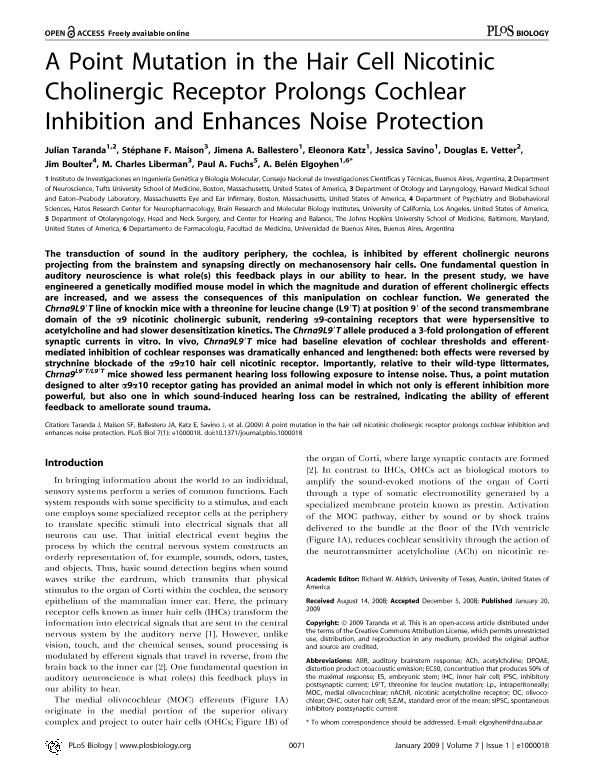Mostrar el registro sencillo del ítem
dc.contributor.author
Taranda, Julian

dc.contributor.author
Maison, Stéphane F.
dc.contributor.author
Ballestero, Jimena Andrea

dc.contributor.author
Katz, Eleonora

dc.contributor.author
Savino, Jessica
dc.contributor.author
Vetter, Douglas E.
dc.contributor.author
Boulter, Jim
dc.contributor.author
Liberman, M. Charles
dc.contributor.author
Fuchs, Paul A.
dc.contributor.author
Elgoyhen, Ana Belen

dc.date.available
2019-07-16T17:17:27Z
dc.date.issued
2009-01
dc.identifier.citation
Taranda, Julian; Maison, Stéphane F.; Ballestero, Jimena Andrea; Katz, Eleonora; Savino, Jessica; et al.; A point mutation in the hair cell nicotinic cholinergic receptor prolongs cochlear inhibition and enhances noise protection; Public Library of Science; PLoS Biology; 7; 1; 1-2009; 71-83
dc.identifier.issn
1544-9173
dc.identifier.uri
http://hdl.handle.net/11336/79632
dc.description.abstract
The transduction of sound in the auditory periphery, the cochlea, is inhibited by efferent cholinergic neurons projecting from the brainstem and synapsing directly on mechanosensory hair cells. One fundamental question in auditory neuroscience is what role(s) this feedback plays in our ability to hear. In the present study, we have engineered a genetically modified mouse model in which the magnitude and duration of efferent cholinergic effects are increased, and we assess the consequences of this manipulation on cochlear function. We generated the Chrna9L9′T of knockin mice with a threonine for leucine change (L9′T) at position 9′ of the second transmembrane domain of the α9 nicotinic cholinergic subunit, rendering α9-containing receptors that were hypersensitive to acetylcholine and had slower desensitization kinetics. The Chrna9L9′T allele produced a 3-fold prolongation of efferent synaptic currents in vitro. In vivo, Chrna9L9′T mice had baseline elevation of cochlear thresholds and efferent-mediated inhibition of cochlear responses was dramatically enhanced and lengthened: both effects were reversed by strychnine blockade of the α9α10 hair cell nicotinic receptor. Importantly, relative to their wild-type littermates, Chrna9L9′T/L9′T mice showed less permanent hearing loss following exposure to intense noise. Thus, a point mutation designed to alter α9α10 receptor gating has provided an animal model in which not only is efferent inhibition more powerful, but also one in which sound-induced hearing loss can be restrained, indicating the ability of efferent feedback to ameliorate sound trauma.
dc.format
application/pdf
dc.language.iso
eng
dc.publisher
Public Library of Science

dc.rights
info:eu-repo/semantics/openAccess
dc.rights.uri
https://creativecommons.org/licenses/by-nc-sa/2.5/ar/
dc.subject
Knock-In Mouse
dc.subject
Nicotinic Cholinergic Receptors
dc.subject
Noise Protection
dc.subject
Efferent Feedback
dc.subject.classification
Biología Celular, Microbiología

dc.subject.classification
Ciencias Biológicas

dc.subject.classification
CIENCIAS NATURALES Y EXACTAS

dc.title
A point mutation in the hair cell nicotinic cholinergic receptor prolongs cochlear inhibition and enhances noise protection
dc.type
info:eu-repo/semantics/article
dc.type
info:ar-repo/semantics/artículo
dc.type
info:eu-repo/semantics/publishedVersion
dc.date.updated
2019-07-11T19:23:42Z
dc.journal.volume
7
dc.journal.number
1
dc.journal.pagination
71-83
dc.journal.pais
Estados Unidos

dc.journal.ciudad
San Francisco
dc.description.fil
Fil: Taranda, Julian. Consejo Nacional de Investigaciones Científicas y Técnicas. Instituto de Investigaciones en Ingeniería Genética y Biología Molecular "Dr. Héctor N. Torres"; Argentina. Tufts University School of Medicine; Estados Unidos
dc.description.fil
Fil: Maison, Stéphane F.. Massachusetts Eye and Ear Infirmary; Estados Unidos
dc.description.fil
Fil: Ballestero, Jimena Andrea. Consejo Nacional de Investigaciones Científicas y Técnicas. Instituto de Investigaciones en Ingeniería Genética y Biología Molecular "Dr. Héctor N. Torres"; Argentina
dc.description.fil
Fil: Katz, Eleonora. Consejo Nacional de Investigaciones Científicas y Técnicas. Instituto de Investigaciones en Ingeniería Genética y Biología Molecular "Dr. Héctor N. Torres"; Argentina
dc.description.fil
Fil: Savino, Jessica. Consejo Nacional de Investigaciones Científicas y Técnicas. Instituto de Investigaciones en Ingeniería Genética y Biología Molecular "Dr. Héctor N. Torres"; Argentina
dc.description.fil
Fil: Vetter, Douglas E.. Tufts University School of Medicine; Estados Unidos
dc.description.fil
Fil: Boulter, Jim. University of California at Los Angeles; Estados Unidos
dc.description.fil
Fil: Liberman, M. Charles. Massachusetts Eye and Ear Infirmary; Estados Unidos
dc.description.fil
Fil: Fuchs, Paul A.. The Johns Hopkins University School of Medicine; Estados Unidos
dc.description.fil
Fil: Elgoyhen, Ana Belen. Consejo Nacional de Investigaciones Científicas y Técnicas. Instituto de Investigaciones en Ingeniería Genética y Biología Molecular "Dr. Héctor N. Torres"; Argentina. Universidad de Buenos Aires. Facultad de Medicina. Departamento de Farmacología; Argentina
dc.journal.title
PLoS Biology

dc.relation.alternativeid
info:eu-repo/semantics/altIdentifier/url/https://journals.plos.org/plosbiology/article?id=10.1371/journal.pbio.1000018
dc.relation.alternativeid
info:eu-repo/semantics/altIdentifier/doi/https://doi.org/10.1371/journal.pbio.1000018
Archivos asociados
